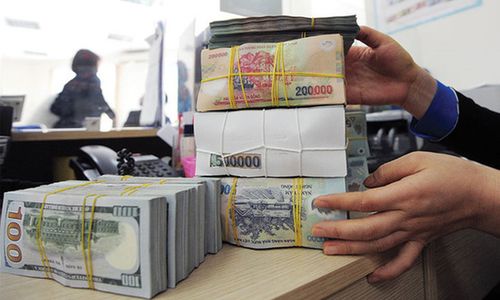 |
The dong appreciated by 0.47 per cent against the greenback last month and continued to strengthen in the first days of July. With the gain, the dong has inched down by only 0.4 per cent against the end of last year.
The State Bank of Viet Nam on Tuesday set the daily reference exchange rate at VND23,051 per dollar, down VND3 from the previous day. With the current trading band of +/- 3 per cent, the ceiling rate applied to commercial banks during the day is VND23,742 and the floor rate at VND22,359.
Commercial banks also continued to depreciate the dollar strongly on the day. Vietcombank listed the buying rate at VND23,210 per dollar and the selling rate at VND23,330, both down VND40 from last Friday.
The rates at BIDV also went down VND40 to VND23,205 for buying and VND23,325 for selling while the cut for buying and selling rates at Techcombank were VND30 and VND20 to VND23,180 and VND23,330, respectively.
Analysts from the Saigon Securities Company attributed the strength of the local currency to the depreciation of the greenback in the global market after safe haven assets such as gold, yen and the Swiss franc dropped in the wake of positive moves from the US and China.
The US and China agreed last Saturday to restart trade talks after the US President Donald Trump offered concessions including no new tariffs and an easing of restrictions on Chinese tech company Huawei in order to reduce tensions with Beijing.
Besides, the belief that the Fed will definitely cut interest rates in July also caused the dollar to weaken in the global market, with the US dollar index (DXY) closing last week at 96.13. Last month alone, most currencies increased against the dollar compared to the previous month, in which the euro was up 1.8 per cent; pound up 0.5 per cent and yuan up 0.55 per cent.
Notably, in the domestic market, an abundant dollar supply source has supported the strength of the dong in the past month, SSI’s analysts said.
SSI’s analysts forecast the USD/VND exchange rate would be steady at VND23,250-23,300 in the coming weeks, buoyed by support from stable domestic factors and an easing of pressure in the global market.
International experts have also forecast the dong would remain stable in the near future, supported by the country’s robust foreign direct investment, a healthy current account surplus, and by the central bank’s active intervention.
Foreign investors disbursed US$1.8 billion last month in Viet Nam, raising the total investment in the first half of the year to $9.1 billion, up 8.7 per cent year-on-year, according to the Ministry of Planning and Investment’s Foreign Investment Agency.
Reports from the General Statistics Office also showed rising export value in June helped Viet Nam gain a trade surplus of nearly $70 million from the beginning of the year to June 15 after posting a trade deficit of $434 million in the first five months.
“The dong will weaken slightly against the dollar to VND23,700 by the end of the year, and average VND23,440 per dollar over 2019, which represents a 1.8 per cent depreciation from the average of 2018,” analysts from the Fitch Group’s Fitch Solutions Macro Research said. — VNS

Vietnam’s local currency bond market returns to upward trend in Q1
Vietnam’s local currency (LCY) bond market reached a size of VND1,193 trillion (US$51 billion) at the end of March, up a marginal 0.7% quarter-on-quarter, a reversal from the 5% quarter-on-quarter contraction in the last quarter of 2018.

Could foreign e-wallets lead to a foreign currency drain?
Nepal on May 21 imposed a ban on transactions with Chinese e-wallets Alipay and WeChat Pay in the country. What about Vietnam?
 The Vietnamese dong has gained some strength against the US dollar in the past month, helped by abundant domestic supply and favourable global conditions.
The Vietnamese dong has gained some strength against the US dollar in the past month, helped by abundant domestic supply and favourable global conditions.